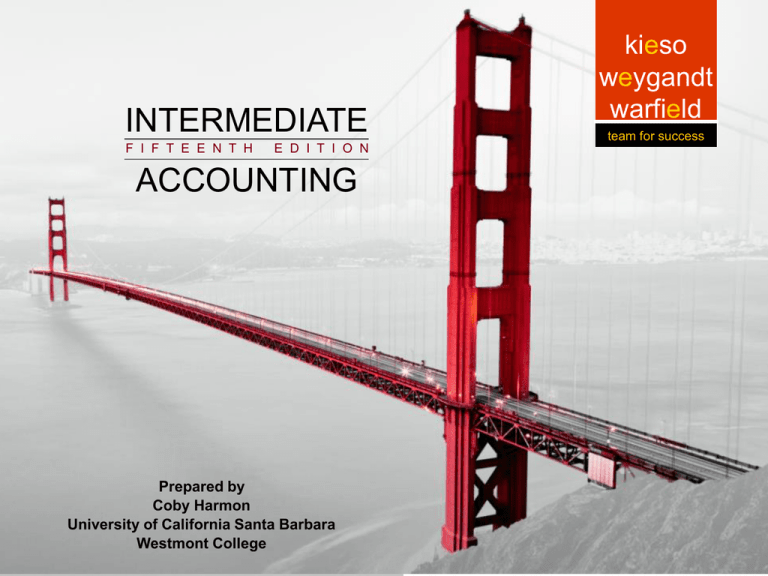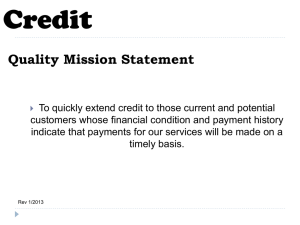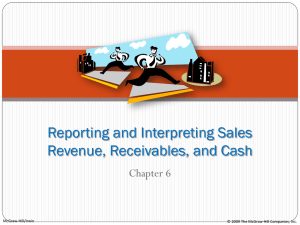
INTERMEDIATE
F I F T E E N T H
E D I T I O N
Intermediate
ACCOUNTING
Intermediate
Accounting
Accounting
7-1
Prepared
by
Prepared
by
Coby Harmon
Prepared by
Coby Harmon
Harmon
University
of California
Santa Barbara
University
of California,
Santa Coby
Barbara
University of California, Santa Barbara
Westmont
College
Westmont
College
kieso
weygandt
warfield
team for success
PREVIEW OF CHAPTER
7
Intermediate Accounting
15th Edition
Kieso Weygandt Warfield
7-2
7
Cash and Receivables
LEARNING OBJECTIVES
After studying this chapter, you should be able to:
7-3
1.
Identify items considered cash.
2.
Indicate how to report cash and related
items.
3.
Define receivables and identify the
different types of receivables.
4.
Explain accounting issues related to
recognition of accounts receivable.
5.
Explain accounting issues related to
valuation of accounts receivable.
6.
Explain accounting issues related to
recognition and valuation of notes
receivable.
7.
Explain the fair value option.
8.
Explain accounting issues related to
disposition of accounts and notes
receivable.
9.
Describe how to report and analyze
receivables.
Cash
What is Cash?
7-4
Most liquid asset.
Standard medium of exchange.
Basis for measuring and accounting for all items.
Current asset.
Examples: coin, currency, available funds on deposit at
the bank, money orders, certified checks, cashier’s checks,
personal checks, bank drafts and savings accounts.
LO 1 Identify items considered cash.
7
Cash and Receivables
LEARNING OBJECTIVES
After studying this chapter, you should be able to:
7-5
1.
Identify items considered cash.
2.
Indicate how to report cash and related
items.
3.
Define receivables and identify the
different types of receivables.
4.
Explain accounting issues related to
recognition of accounts receivable.
5.
Explain accounting issues related to
valuation of accounts receivable.
6.
Explain accounting issues related to
recognition and valuation of notes
receivable.
7.
Explain the fair value option.
8.
Explain accounting issues related to
disposition of accounts and notes
receivable.
9.
Describe how to report and analyze
receivables.
Cash
Reporting Cash
Cash Equivalents
Short-term, highly liquid investments that are both
a) readily convertible to cash, and
b) so near their maturity that they present insignificant
risk of changes in value.
Examples: Treasury bills, Commercial paper, and Money
market funds.
7-6
LO 2 Indicate how to report cash and related items.
Reporting Cash
Restricted Cash
Companies segregate restricted cash from “regular” cash.
Examples, restricted for:
(1) plant expansion, (2) retirement of long-term debt, and
(3) compensating balances.
Illustration 7-1
7-7
LO 2
Reporting Cash
Bank Overdrafts
Company writes a check for more than the amount in its
cash account.
7-8
Generally reported as a current liability.
Offset against other cash accounts only when
accounts are with the same bank.
LO 2 Indicate how to report cash and related items.
Cash-Related Items
Illustration 7-2
7-9
LO 2
7
Cash and Receivables
LEARNING OBJECTIVES
After studying this chapter, you should be able to:
1.
Identify items considered cash.
2.
Indicate how to report cash and related
items.
3.
Define receivables and identify the
different types of receivables.
4.
Explain accounting issues related to
recognition of accounts receivable.
5.
Explain accounting issues related to
valuation of accounts receivable.
7-10
6.
Explain accounting issues related to
recognition and valuation of notes
receivable.
7.
Explain the fair value option.
8.
Explain accounting issues related to
disposition of accounts and notes
receivable.
9.
Describe how to report and analyze
receivables.
Accounts Receivable
Receivables - Claims held against customers and
others for money, goods, or services.
7-11
Oral promises of the
purchaser to pay for goods
and services sold.
Written promises to pay a
sum of money on a
specified future date.
Accounts
Receivable
Notes
Receivable
LO 3 Define receivables and identify the different types of receivables.
Accounts Receivable
Nontrade Receivables
1. Advances to officers and employees.
2. Advances to subsidiaries.
3. Deposits paid to cover potential damages or losses.
4. Deposits paid as a guarantee of performance or payment.
5. Dividends and interest receivable.
6. Claims against: Insurance companies for casualties sustained;
defendants under suit; governmental bodies for tax refunds;
common carriers for damaged or lost goods; creditors for returned,
damaged, or lost goods; customers for returnable items (crates,
containers, etc.).
7-12
LO 3 Define receivables and identify the different types of receivables.
Accounts Receivable
Nontrade Receivables
Illustration 7-3
Receivables Balance
Sheet Presentations
7-13
LO 3 Define receivables and identify the different types of receivables.
7
Cash and Receivables
LEARNING OBJECTIVES
After studying this chapter, you should be able to:
1.
Identify items considered cash.
2.
Indicate how to report cash and related
items.
3.
Define receivables and identify the
different types of receivables.
4.
Explain accounting issues related to
recognition of accounts receivable.
5.
Explain accounting issues related to
valuation of accounts receivable.
7-14
6.
Explain accounting issues related to
recognition and valuation of notes
receivable.
7.
Explain the fair value option.
8.
Explain accounting issues related to
disposition of accounts and notes
receivable.
9.
Describe how to report and analyze
receivables.
Recognition of Accounts Receivables
Trade Discounts
7-15
Reductions from the list
price.
Not recognized in the
accounting records.
Customers are billed net
of discounts.
10 %
Discount for
new Retail
Store
Customers
LO 4 Explain accounting issues related to recognition of accounts receivable.
Recognition of Accounts Receivables
Cash Discounts (Sales Discounts)
7-16
Offered to induce prompt
payment.
Gross Method vs. Net
Method.
Payment
terms are
2/10, n/30
LO 4 Explain accounting issues related to recognition of accounts receivable.
Recognition of Accounts Receivables
Cash Discounts (Sales Discounts)
7-17
Illustration 7-4
LO 4 Explain accounting issues related to recognition of accounts receivable.
Recognition of Accounts Receivables
Illustration: On June 3, Bolton Company sold to Arquette Company
merchandise having a sale price of $2,000 with terms of 2/10, n/60, f.o.b.
shipping point. On June 12, the company received a check for the
balance due from Arquette Company. Prepare the journal entries on
Bolton Company books to record the sale assuming Bolton records sales
using the gross method.
June 3
Accounts Receivable
2,000
Sales
June 12
Cash ($2,000 x 98%)
Sales Discounts
Accounts Receivable
7-18
2,000
1,960
40
2,000
LO 4 Explain accounting issues related to recognition of accounts receivable.
Recognition of Accounts Receivables
Illustration: On June 3, Bolton Company sold to Arquette Company
merchandise having a sale price of $2,000 with terms of 2/10, n/60, f.o.b.
shipping point. On June 12, the company received a check for the
balance due from Arquette Company. Prepare the journal entries on
Bolton Company books to record the sale assuming Bolton records sales
using the net method.
June 3
Accounts Receivable
1,960
Sales
June 12
Cash ($2,000 x 98%)
Accounts Receivable
7-19
1,960
1,960
1,960
LO 4 Explain accounting issues related to recognition of accounts receivable.
Recognition of Accounts Receivables
Illustration: On June 3, Bolton Company sold to Arquette Company
merchandise having a sale price of $2,000 with terms of 2/10, n/60, f.o.b.
shipping point. Prepare the journal entries on Bolton Company books to
record the sale assuming Bolton records sales using the net method,
and Arquette did not remit payment until July 29.
June 3
Accounts Receivable
1,960
Sales
June 12
Cash
Accounts Receivable
Sales Discounts Forfeited
7-20
1,960
2,000
1,960
40
LO 4 Explain accounting issues related to recognition of accounts receivable.
Recognition of Accounts Receivables
Non-Recognition of Interest Element
A company should measure receivables in terms of their
present value.
In practice, companies ignore
interest revenue related to accounts
receivable because the discount is
not usually material in relation to
the net income for the period.
7-21
LO 4 Explain accounting issues related to recognition of accounts receivable.
Accounts Receivables
How are these accounts presented on the Balance Sheet?
Accounts Receivable
Allowance for
Doubtful Accounts
Beg.
500
25
Beg.
End.
500
25
End.
7-22
LO 4 Explain accounting issues related to recognition of accounts receivable.
Accounts Receivables
ABC Corporation
Balance Sheet (partial)
Current Assets:
Cash
Accounts receivable
500
Less: Allowance for doubtful accounts
(25)
Inventory
Prepaid expense
Total current assets
7-23
$
330
475
812
40
1,657
LO 4 Explain accounting issues related to recognition of accounts receivable.
Accounts Receivables
ABC Corporation
Balance Sheet (partial)
Alternate
Presentation
Current Assets:
Cash
330
Accounts receivable, net of $25 allowance
475
Inventory
812
Prepaid expense
Total current assets
7-24
$
40
1,657
LO 4 Explain accounting issues related to recognition of accounts receivable.
Accounts Receivables
Journal entry for credit sale of $100?
Accounts Receivable
Sales
Accounts Receivable
100
100
Allowance for
Doubtful Accounts
Beg.
500
25
Beg.
End.
500
25
End.
7-25
LO 4 Explain accounting issues related to recognition of accounts receivable.
Accounts Receivables
Journal entry for credit sale of $100?
Accounts Receivable
Sales
Accounts Receivable
Beg.
500
Sale
100
End.
600
7-26
100
100
Allowance for
Doubtful Accounts
25
Beg.
25
End.
LO 4 Explain accounting issues related to recognition of accounts receivable.
Accounts Receivables
Collected $333 on account?
Cash
333
Accounts Receivable
Accounts Receivable
Beg.
500
Sale
100
End.
600
7-27
333
Allowance for
Doubtful Accounts
25
Beg.
25
End.
LO 4 Explain accounting issues related to recognition of accounts receivable.
Accounts Receivables
Collected $333 on account?
Cash
333
Accounts Receivable
Accounts Receivable
Beg.
500
Sale
100
End.
267
7-28
333
333
Allowance for
Doubtful Accounts
25
Beg.
25
End.
Coll.
LO 4 Explain accounting issues related to recognition of accounts receivable.
Accounts Receivables
Adjustment of $15 for estimated bad debts?
Bad Debt Expense
15
Allowance for Doubtful Accounts
Accounts Receivable
Beg.
500
Sale
100
End.
267
7-29
333
15
Allowance for
Doubtful Accounts
25
Beg.
25
End.
Coll.
LO 4 Explain accounting issues related to recognition of accounts receivable.
Accounts Receivables
Adjustment of $15 for estimated bad debts?
Bad Debt Expense
15
Allowance for Doubtful Accounts
Accounts Receivable
Beg.
500
Sale
100
End.
267
7-30
333
Coll.
15
Allowance for
Doubtful Accounts
25
Beg.
15
Est.
40
End.
LO 4 Explain accounting issues related to recognition of accounts receivable.
Accounts Receivables
Write-off of uncollectible accounts for $10?
Allowance for Doubtful accounts
Accounts Receivable
Accounts Receivable
Beg.
500
Sale
100
End.
267
7-31
333
Coll.
10
10
Allowance for
Doubtful Accounts
25
Beg.
15
Est.
40
End.
LO 4 Explain accounting issues related to recognition of accounts receivable.
Accounts Receivables
Write-off of uncollectible accounts for $10?
Allowance for Doubtful accounts
10
Accounts Receivable
Accounts Receivable
Beg.
500
Sale
100
End.
7-32
257
333
Coll.
10
W/O
10
Allowance for
Doubtful Accounts
W/O
25
Beg.
15
Est.
30
End.
10
LO 4 Explain accounting issues related to recognition of accounts receivable.
Accounts Receivables
ABC Corporation
Balance Sheet (partial)
Current Assets:
Cash
330
Accounts receivable, net of $30 allowance
227
Merchandise inventory
812
Prepaid expense
Total current assets
7-33
$
40
1,409
LO 4 Explain accounting issues related to recognition of accounts receivable.
7
Cash and Receivables
LEARNING OBJECTIVES
After studying this chapter, you should be able to:
1.
Identify items considered cash.
2.
Indicate how to report cash and related
items.
3.
Define receivables and identify the
different types of receivables.
4.
Explain accounting issues related to
recognition of accounts receivable.
5.
Explain accounting issues related to
valuation of accounts receivable.
7-34
6.
Explain accounting issues related to
recognition and valuation of notes
receivable.
7.
Explain the fair value option.
8.
Explain accounting issues related to
disposition of accounts and notes
receivable.
9.
Describe how to report and analyze
receivables.
Accounts Receivable
Valuation of Accounts Receivable
Reporting of receivables involves
1) classification and
2) valuation on the balance sheet.
7-35
Classification involves determining the length of time each
receivable will be outstanding.
Value and report short-term receivables at net realizable
value.
LO 5 Explain accounting issues related to valuation of accounts receivable.
Valuation of Accounts Receivable
Uncollectible Accounts Receivable
Record credit losses as debits to Bad Debt Expense (or
Uncollectible Accounts Expense).
Normal and necessary risk of doing business on credit.
Two methods to account for uncollectible accounts:
1) the direct write-off method and
2) the allowance method.
7-36
LO 5 Explain accounting issues related to valuation of accounts receivable.
Valuation of Accounts Receivable
Methods of Accounting for Uncollectible Accounts
Direct Write-Off
Theoretically deficient:
Losses are estimated:
No matching.
Percentage-of-sales.
Receivable not stated at
cash realizable value.
Percentage-of-receivables.
GAAP requires when
material in amount.
7-37
Allowance Method
Not GAAP when material in
amount.
LO 5 Explain accounting issues related to valuation of accounts receivable.
Valuation of Accounts Receivable
Illustration 7-6
The percentage-of-sales basis
results in a better matching of
expenses with revenues
7-38
The percentage-of-receivables
basis produces the better estimate of
net realizable value
LO 5 Explain accounting issues related to valuation of accounts receivable.
Valuation of Accounts Receivable
Percentage-of-Sales Approach
7-39
Percentage based upon past experience and anticipate
credit policy.
Achieves better matching of expenses with revenues.
Any balance in Allowance for Doubtful Accounts is
ignored.
LO 5 Explain accounting issues related to valuation of accounts receivable.
Valuation of Accounts Receivable
Illustration: Gonzalez Company estimates that about 1% of net
credit sales become uncollectible. If net credit sales for are
$800,000 for the year, it records bad debt expense as follows.
Bad Debt Expense
Allowance for Doubtful Accounts
8,000
8,000
Illustration 7-7
7-40
LO 5
Valuation of Accounts Receivable
Percentage-of-Receivables Approach
Not matching.
Reports estimate of receivables at realizable value.
Companies may apply this method using
7-41
one composite rate, or
an aging schedule using different rates.
LO 5 Explain accounting issues related to valuation of accounts receivable.
Valuation of Accounts Receivable
Illustration 7-8
Accounts Receivable
Aging Schedule
What entry
would Wilson
make assuming
that the
allowance
account had a
zero balance?
Bad Debt Expense
Allowance for Doubtful Accounts
7-42
37,650
37,650
LO 5 Explain accounting issues related to valuation of accounts receivable.
Valuation of Accounts Receivable
Illustration 7-8
Accounts Receivable
Aging Schedule
What entry
would Wilson
make assuming
the allowance
account had a
credit balance
of $800 before
adjustment?
Bad Debt Expense ($37,650 – $800)
Allowance for Doubtful Accounts
7-43
36,850
36,850
LO 5 Explain accounting issues related to valuation of accounts receivable.
Valuation of Accounts Receivable
Illustration: Sandel Company reports the following financial
information before adjustments.
Instructions: Prepare the journal entry to record bad debt
expense assuming Sandel Company estimates bad debts
at (a) 1% of net sales and (b) 5% of accounts receivable.
7-44
LO 5 Explain accounting issues related to valuation of accounts receivable.
Valuation of Accounts Receivable
Illustration: Sandel Company reports the following financial
information before adjustments.
Instructions: Prepare the journal entry assuming Sandel
estimates bad debts at (b) 1% of net sales.
Bad Debt Expense
Allowance for Doubtful Accounts
7,500
7,500
($800,000 – $50,000) x 1% = $7,500
7-45
LO 5
Valuation of Accounts Receivable
Illustration: Sandel Company reports the following financial
information before adjustments.
Instructions: Prepare the journal entry assuming Sandel
estimates bad debts at (b) 5% of accounts receivable.
Bad Debt Expense
Allowance for Doubtful Accounts
6,000
6,000
($160,000 x 5%) – $2,000) = $6,000
7-46
LO 5
Write-Off of Uncollectible Accounts
Illustration: The financial vice president of Brown Furniture
authorizes a write-off of the $1,000 balance owed by Randall Co. in
March 1. The entry to record the write-off is:
Allowance for Doubtful Accounts
1,000
Accounts Receivable
1,000
Assume that on July 1, Randall Co. pays the $1,000 amount that
Brown had written off on March 1. These are the entries:
7-47
Accounts Receivable
Allowance for Doubtful Accounts
1,000
Cash
Accounts Receivable
1,000
1,000
1,000
LO 5
7
Cash and Receivables
LEARNING OBJECTIVES
After studying this chapter, you should be able to:
1.
Identify items considered cash.
2.
Indicate how to report cash and related
items.
3.
Define receivables and identify the
different types of receivables.
4.
Explain accounting issues related to
recognition of accounts receivable.
5.
Explain accounting issues related to
valuation of accounts receivable.
7-48
6.
Explain accounting issues related to
recognition and valuation of notes
receivable.
7.
Explain the fair value option.
8.
Explain accounting issues related to
disposition of accounts and notes
receivable.
9.
Describe how to report and analyze
receivables.
Notes Receivable
Supported by a formal promissory note.
7-49
Written promise to pay a certain sum of money at a specific
future date.
A negotiable instrument.
Maker signs in favor of a Payee.
Interest-bearing (has a stated rate of interest) OR
Zero-interest-bearing (interest included in face amount).
LO 6 Explain accounting issues related to recognition
and valuation of notes receivable.
Notes Receivable
Generally originate from:
7-50
Customers who need to extend payment period of an
outstanding receivable.
High-risk or new customers.
Loans to employees and subsidiaries.
Sales of property, plant, and equipment.
Lending transactions (majority of notes).
LO 6 Explain accounting issues related to recognition
and valuation of notes receivable.
Recognition of Notes Receivable
7-51
Short-Term
Long-Term
Record at
Face Value,
less allowance
Record at
Present Value
of cash expected to
be collected
Interest Rates
Note Issued at
Stated rate = Market rate
Face Value
Stated rate > Market rate
Premium
Stated rate < Market rate
Discount
LO 6
Note Issued at Face Value
Illustration: Bigelow Corp. lends Scandinavian Imports
$10,000 in exchange for a $10,000, three-year note bearing
interest at 10 percent annually. The market rate of interest for a
note of similar risk is also 10 percent. How does Bigelow record
the receipt of the note?
i = 10%
$10,000 Principal
0
$1,000
1,000
1
2
1,000 Interest
3
4
n=3
7-52
LO 6 Explain accounting issues related to recognition
and valuation of notes receivable.
Note Issued at Face Value
PV of Interest
$1,000
x
Interest Received
7-53
2.48685
Factor
=
$2,487
Present Value
LO 6 Explain accounting issues related to recognition
and valuation of notes receivable.
Note Issued at Face Value
PV of Principal
$10,000
Principal
7-54
x
.75132
Factor
=
$7,513
Present Value
LO 6 Explain accounting issues related to recognition
and valuation of notes receivable.
Note Issued at Face Value
Summary
Present value of interest
$ 2,487
Present value of principal
7,513
Note current market value
$10,000
Journal Entries
Jan. yr. 1
Dec. yr. 1
7-55
Notes Receivable
Cash
Cash
Interest Revenue
10,000
10,000
1,000
1,000
LO 6 Explain accounting issues related to recognition
and valuation of notes receivable.
Zero-Interest-Bearing Note
Illustration: Jeremiah Company receives a three-year, $10,000
zero-interest-bearing note. The market rate of interest for a
note of similar risk is 9 percent. How does Jeremiah record the
receipt of the note?
i = 9%
$10,000 Principal
0
$0
$0
1
2
$0 Interest
3
4
n=3
7-56
LO 6 Explain accounting issues related to recognition
and valuation of notes receivable.
Zero-Interest-Bearing Note
PV of Principal
$10,000
Principal
7-57
x
.77218
Factor
=
$7,721.80
Present Value
LO 6 Explain accounting issues related to recognition
and valuation of notes receivable.
Zero-Interest-Bearing Note
Illustration 7-12
7-58
LO 6 Explain accounting issues related to recognition
and valuation of notes receivable.
Zero-Interest-Bearing Note
Illustration 7-12
Prepare the
journal entry to
record the receipt
of the note.
Notes Receivable
7-59
10,000.00
Discount on Notes Receivable
2,278.20
Cash
7,721.80
LO 6 Explain accounting issues related to recognition
and valuation of notes receivable.
Zero-Interest-Bearing Note
Illustration 7-12
Prepare the
journal entry to
record interest
revenue at the
end of the first
year.
Discount on Notes Receivable
Interest Revenue
7-60
694.96
694.96
LO 6 Explain accounting issues related to recognition
and valuation of notes receivable.
Interest-Bearing Note
Illustration: Morgan Corp. makes a loan to Marie Co. and
receives in exchange a three-year, $10,000 note bearing interest
at 10 percent annually. The market rate of interest for a note of
similar risk is 12 percent. Prepare the journal entry to record the
receipt of the note?
i = 12%
$10,000 Principal
0
$1,000
1,000
1
2
1,000 Interest
3
4
n=3
7-61
LO 6 Explain accounting issues related to recognition
and valuation of notes receivable.
Interest-Bearing Note
PV of Interest
$1,000
x
Interest Received
7-62
2.40183
Factor
=
$2,402
Present Value
LO 6 Explain accounting issues related to recognition
and valuation of notes receivable.
Interest-Bearing Note
PV of Principal
$10,000
Principal
7-63
x
.71178
Factor
=
$7,118
Present Value
LO 6 Explain accounting issues related to recognition
and valuation of notes receivable.
Interest-Bearing Note
Illustration: Record the receipt of the note?
Illustration 7-14
Notes Receivable
Discount on Notes Receivable
Cash
7-64
10,000
480
9,520
LO 6 Explain accounting issues related to recognition
and valuation of notes receivable.
Interest-Bearing Note
Illustration 7-15
7-65
LO 6 Explain accounting issues related to recognition
and valuation of notes receivable.
Zero-Interest-Bearing Note
Illustration 7-15
Prepare the journal
entry to record
interest revenue at
the end of the first
year.
Cash
1,000
Discount on Notes Receivable
Interest Revenue
7-66
142
1,142
LO 6 Explain accounting issues related to recognition
and valuation of notes receivable.
Recognition of Notes Receivable
Notes Received for Property, Goods, or Services
In a bargained transaction entered into at arm’s length, the
stated interest rate is presumed to be fair unless:
1. No interest rate is stated, or
2. Stated interest rate is unreasonable, or
3. Face amount of the note is materially different from the
current cash sales price.
7-67
LO 6 Explain accounting issues related to recognition
and valuation of notes receivable.
Recognition of Notes Receivable
Illustration: Oasis Development Co. sold a corner lot to Rusty
Pelican as a restaurant site. Oasis accepted in exchange a five-year
note having a maturity value of $35,247 and no stated interest rate.
The land originally cost Oasis $14,000. At the date of sale the land
had a fair market value of $20,000. Oasis uses the fair market value
of the land, $20,000, as the present value of the note. Oasis therefore
records the sale as:
($35,247 - $20,000) = $15,247
Notes Receivable
Discount on Notes Receivable
Land
Gain on Disposal of Land
7-68
35,247
15,247
14,000
6,000
LO 6 Explain accounting issues related to recognition
and valuation of notes receivable.
Notes Receivable
Valuation of Notes Receivable
Short-Term reported at net realizable value (same as
accounting for accounts receivable).
Long-Term - FASB requires companies disclose not
only their cost but also their fair value in the notes to the
financial statements.
7-69
LO 6 Explain accounting issues related to recognition
and valuation of notes receivable.
7
Cash and Receivables
LEARNING OBJECTIVES
After studying this chapter, you should be able to:
1.
Identify items considered cash.
2.
Indicate how to report cash and related
items.
3.
Define receivables and identify the
different types of receivables.
4.
Explain accounting issues related to
recognition of accounts receivable.
5.
Explain accounting issues related to
valuation of accounts receivable.
7-70
6.
Explain accounting issues related to
recognition and valuation of notes
receivable.
7.
Explain the fair value option.
8.
Explain accounting issues related to
disposition of accounts and notes
receivable.
9.
Describe how to report and analyze
receivables.
Special Issues
Fair Value Option
Companies have the option to use fair value as the basis
of measurement in the financial statements.
If companies choose the fair value option
7-71
►
Receivables are recorded at fair value.
►
Unrealized holding gains or losses reported as part of
net income.
Company reports the receivable at fair value each
reporting date.
LO 7 Explain the fair value option.
Special Issues
Fair Value Option
7-72
Companies may elect at time the financial instrument is
►
originally recognized or
►
when some event triggers a new basis of accounting.
Must continue to use fair value measurement for the specific
instrument until the company no longer owns this
instrument.
If not elected at date of recognition, company may never
use fair value option on that specific instrument.
LO 7 Explain the fair value option.
Valuation of Notes Receivable
Illustration: Escobar Company has notes receivable that have a
fair value of $810,000 and a carrying amount of $620,000. Escobar
decides on December 31, of the current year, to use the fair value
option for these receivables. This is the first valuation of these
recently acquired receivables. At December 31, Escobar makes an
adjusting entry to record the increase in value of Notes Receivable
and to record the unrealized holding gain, as follows.
Notes Receivable
190,000
Unrealized Holding Gain or Loss—Income
7-73
190,000
LO 7 Explain the fair value option.
7
Cash and Receivables
LEARNING OBJECTIVES
After studying this chapter, you should be able to:
1.
Identify items considered cash.
2.
Indicate how to report cash and related
items.
3.
Define receivables and identify the
different types of receivables.
4.
Explain accounting issues related to
recognition of accounts receivable.
5.
Explain accounting issues related to
valuation of accounts receivable.
7-74
6.
Explain accounting issues related to
recognition and valuation of notes
receivable.
7.
Explain the fair value option.
8.
Explain accounting issues related to
disposition of accounts and notes
receivable.
9.
Describe how to report and analyze
receivables.
Disposition of Accounts and Notes Receivable
Owner may transfer accounts or notes receivables to
another company for cash. Reasons:
Competition.
Sell receivables because money is tight.
Billing and collection are time-consuming and costly.
Transfer accomplished by:
7-75
Secured borrowing.
Sale of receivables.
LO 8 Explain accounting issues related to disposition
of accounts and notes receivable.
Disposition of Accounts and Notes Receivable
Secured Borrowing
Illustration: March 1, 2014, Howat Mills, Inc. provides
(assigns) $700,000 of its accounts receivable to Citizens Bank
as collateral for a $500,000 note. Howat Mills continues to
collect the accounts receivable; the account debtors are not
notified of the arrangement. Citizens Bank assesses a finance
charge of 1 percent of the accounts receivable and interest on
the note of 12 percent. Howat Mills makes monthly payments to
the bank for all cash it collects on the receivables.
7-76
LO 8 Explain accounting issues related to disposition
of accounts and notes receivable.
Secured Borrowing
Illustration 7-16
7-77
LO 8
Secured Borrowing
Illustration: On April 1, 2014, Prince Company assigns $500,000 of its
accounts receivable to the Third National Bank as collateral for a $300,000
loan due July 1, 2014. The assignment agreement calls for Prince
Company to continue to collect the receivables. Third National Bank
assesses a finance charge of 2% of the accounts receivable, and interest
on the loan is 10% (a realistic rate of interest for a note of this type).
Instructions:
7-78
a)
Prepare the April 1, 2014, journal entry for Prince Company.
b)
Prepare the journal entry for Prince’s collection of $350,000 of the
accounts receivable during the period from April 1, 2014, through
June 30, 2014.
c)
On July 1, 2014, Prince paid Third National all that was due from the
loan it secured on April 1, 2014.
LO 8 Explain accounting issues related to disposition
of accounts and notes receivable.
Secured Borrowing
Instructions:
a)
Prepare the April 1, 2014, journal entry for Prince Company.
b)
Prepare the journal entry for Prince’s collection of $350,000.
c)
On July 1, 2014, Prince paid Third National all that was.
a)
Cash
Finance Charge ($500,000 x 2%)
Notes Payable
b)
Cash
290,000
10,000
300,000
350,000
Accounts Receivable
c)
Notes Payable
Interest Expense (10% x $300,000 x 3/12)
Cash
7-79
350,000
300,000
7,500
307,500
LO 8
Disposition of Accounts and Notes Receivable
Sales of Receivables
Sale Without Recourse
Purchaser assumes risk of collection.
Transfer is outright sale of receivable.
Seller records loss on sale.
Sale With Recourse
7-80
Seller guarantees payment to purchaser.
Financial components approach used to record transfer.
LO 8 Explain accounting issues related to disposition
of accounts and notes receivable.
Sales of Receivables
Factors are finance companies or banks that buy receivables
from businesses for a fee.
Illustration 7-17
7-81
LO 8
Sales of Receivables
Illustration: Crest Textiles, Inc. factors $500,000 of accounts
receivable with Commercial Factors, Inc., on a without recourse
basis. Commercial Factors assesses a finance charge of 3 percent of
the amount of accounts receivable and retains an amount equal to 5
percent of the accounts receivable (for probable adjustments). Crest
Textiles and Commercial Factors make the following journal entries for
the receivables transferred without recourse.
Illustration 7-18
7-82
LO 8 Explain accounting issues related to disposition
of accounts and notes receivable.
Sales of Receivables
Illustration: Assume Crest Textiles sold the receivables on a with
recourse basis. Crest Textiles determines that this recourse
obligation has a fair value of $6,000. To determine the loss on the
sale of the receivables, Crest Textiles computes the net proceeds
from the sale as follows.
Illustration 7-19
Net Proceeds
Computation
Illustration 7-20
Loss on Sale
Computation
7-83
LO 8
Sales of Receivables
Illustration: Prepare the journal entries for both Crest Textiles and
Commercial Factors for the receivables sold with recourse.
Crest
Textiles, Inc.
Commercial
Factors, Inc.
7-84
Cash
Due from Factor
Loss on Sale of Receivables
Accounts (Notes) Receivable
Recourse Liability
460,000
25,000
21,000
Accounts Receivable
500,000
Due to Customer (Crest Textiles)
Interest Revenue
Cash
500,000
6,000
25,000
15,000
460,000
LO 8
Secured Borrowing versus Sale
Illustration 7-22
The FASB concluded
that a sale occurs
only if the seller
surrenders control of
the receivables to the
buyer.
Three conditions
must be met.
7-85
LO 8
7
Cash and Receivables
LEARNING OBJECTIVES
After studying this chapter, you should be able to:
1.
Identify items considered cash.
2.
Indicate how to report cash and related
items.
3.
Define receivables and identify the
different types of receivables.
4.
Explain accounting issues related to
recognition of accounts receivable.
5.
Explain accounting issues related to
valuation of accounts receivable.
7-86
6.
Explain accounting issues related to
recognition and valuation of notes
receivable.
7.
Explain the fair value option.
8.
Explain accounting issues related to
disposition of accounts and notes
receivable.
9.
Describe how to report and analyze
receivables.
Presentation and Analysis
Presentation of Receivables
7-87
1.
Segregate the different types of receivables that a company
possesses, if material.
2.
Appropriately offset the valuation accounts against the proper
receivable accounts.
3.
Determine that receivables classified in the current assets section
will be converted into cash within the year or the operating cycle,
whichever is longer.
4.
Disclose any loss contingencies that exist on the receivables.
5.
Disclose any receivables designated or pledged as collateral.
6.
Disclose the nature of credit risk inherent in the receivables.
LO 9 Describe how to report and analyze receivables.
Presentation and Analysis
Analysis of Receivables
Accounts Receivable Turnover Ratio:
Use to evaluate the liquidity of accounts receivable.
Measures the number of times, on average, a company
collects receivables during the period.
Illustration 7-24
7-88
LO 9 Describe how to report and analyze receivables.
APPENDIX
7A
CASH CONTROLS
Management faces two problems in accounting for cash
transactions:
1. Establish proper controls to prevent any unauthorized
transactions by officers or employees.
2. Provide information necessary to properly manage cash on
hand and cash transactions.
7-89
LO 10 Explain common techniques employed to control cash.
APPENDIX
7A
CASH CONTROLS
Using Bank Accounts
To obtain desired control objectives, a company can vary the
number and location of banks and the types of accounts.
7-90
General checking account
Collection float.
Lockbox accounts
Imprest bank accounts
LO 10 Explain common techniques employed to control cash.
APPENDIX
7A
CASH CONTROLS
The Imprest Petty Cash System
To pay small amounts for miscellaneous expenses.
Steps:
1. Record $300 transfer of funds to petty cash:
Petty Cash
Cash
300
300
2. The petty cash custodian obtains signed receipts from
each individual to whom he or she pays cash.
7-91
LO 10 Explain common techniques employed to control cash.
APPENDIX
7A
CASH CONTROLS
The Imprest Petty Cash System
Steps:
3. Custodian receives a company check to replenish the
fund.
Supplies Expense
42
Postage Expense
53
Miscellaneous Expense
76
Cash Over and Short
Cash
7-92
2
173
LO 10 Explain common techniques employed to control cash.
APPENDIX
7A
CASH CONTROLS
The Imprest Petty Cash System
Steps:
4. If the company decides that the amount of cash in the
petty cash fund is excessive by $50, it lowers the fund
balance as follows.
Cash
50
Petty cash
7-93
50
LO 10 Explain common techniques employed to control cash.
APPENDIX
7A
CASH CONTROLS
Physical Protection of Cash Balances
Company should
7-94
Minimize the cash on hand.
Only have on hand petty cash and current day’s receipts.
Keep funds in a vault, safe, or locked cash drawer.
Transmit each day’s receipts to the bank as soon as practicable.
Periodically prove (reconcile) the balance shown in the general
ledger.
LO 10 Explain common techniques employed to control cash.
APPENDIX
7A
CASH CONTROLS
Reconciliation of Bank Balances
Schedule explaining any differences between the bank’s
and the company’s records of cash.
Reconciling Items:
1. Deposits in transit.
2. Outstanding checks.
3. Bank charges and credits.
Time Lags
4. Bank or Depositor errors.
7-95
LO 10 Explain common techniques employed to control cash.
APPENDIX
7A
CASH CONTROLS
Reconciliation of Bank Balances
7-96
Illustration 7A-1
Bank Reconciliation
Form and Content
LO 10 Explain common techniques employed to control cash.
APPENDIX
7-97
7A
CASH CONTROLS
LO 10
APPENDIX
7A
CASH CONTROLS
Illustration 7A-2
7-98
Advance slide in presentation mode to reveal answer.
APPENDIX
7A
CASH CONTROLS
Illustration: Journalize the adjusting entry on the books of
Nugget Mining Company.
Nov. 30
Cash
542
Office Expense
Accounts Receivable
7-99
18
220
Accounts Payable
180
Interest Revenue
600
LO 10 Explain common techniques employed to control cash.
APPENDIX
7A
CASH CONTROLS
Question
The reconciling item in a bank reconciliation that will result
in an adjusting entry by the depositor is:
a. outstanding checks.
b. deposit in transit.
c. a bank error.
d. bank service charges.
7-100
LO 10 Explain common techniques employed to control cash.
APPENDIX
7B
IMPAIRMENT OF RECEIVABLES
Companies evaluate their receivables to determine their
ultimate collectibility.
Allowance method is appropriate when:
probable that an asset has been impaired and
amount of the loss can be reasonably estimated.
Long-term receivables such as loans that are identified as
impaired, companies perform an additional impairment
evaluation.
7-101
LO 11 Describe the accounting for a loan impairment.
APPENDIX
7B
IMPAIRMENT OF RECEIVABLES
Impairment Measurement and Reporting
Impairment loss is calculated as the difference between
7-102
the investment in the loan (generally the principal plus
accrued interest) and
the expected future cash flows discounted at the loan’s
historical effective-interest rate.
LO 11 Describe the accounting for a loan impairment.
APPENDIX
7B
IMPAIRMENT OF RECEIVABLES
Illustration: At December 31, 2013, Ogden Bank recorded an
investment of $100,000 in a loan to Carl King. The loan has an
historical effective-interest rate of 10 percent, the principal is due in full
at maturity in three years, and interest is due annually. The loan officer
performs a review of the loan’s expected future cash flow and utilizes
the present value method for measuring the required impairment loss.
Illustration 7B-1
7-103
LO 11 Describe the accounting for a loan impairment.
APPENDIX
7B
IMPAIRMENT OF RECEIVABLES
Illustration: Computation of impairment loss.
Illustration 7B-2
Recording Impairment Loss
Bad Debt Expense
12,434
Allowance for Doubtful Accounts
7-104
12,434
LO 11 Describe the accounting for a loan impairment.
LOST IN TRANSLATION
WHAT’S
YOUR PRINCIPLE
Floyd Norris, noted financial writer for the New
York Times, recently wrote in his blog that he
attended a conference to discuss the financial
crisis in subprime lending. He highlighted, and
provided “translations” of, some of the statements
he heard at that conference:
• “There is a problem of misaligned incentives.”
Translation: Many parties in the lending
process were complicit in not performing due
diligence on loans because there were lots of
fees to be had if the loans were made, good
loans or bad.
• “It is pretty clear that there was a failure in
some key assumptions that were supporting
our analytics and our models.”
Translation: The rating agencies that
evaluated the risk level of these securities
made many miscalculations. Some structured
finance products that were given superior
ratings are no longer worth much.
• “The plumbing of the U.S. economy has been
deeply damaged. It is a long window of
vulnerability.”
7-105
Translation: The U.S. has caused a financial
crisis as a result of poor lending practices,
and many financial institutions are fighting to
survive.
• “I’m glad that this time we did not cause it.”
Translation: Other countries realized they had
caused financial crises in the past but were
not to blame for the current U.S. financial
situation.
• “What you see is what you get. If you don’t
see it, it will get you.”
Translation: A large number of financial
institutions have to take losses on assets that
are not reported on their balance sheet. Their
continuing interest in some of the loans that
they supposedly sold is now coming back to
them and they will have to report losses.
Source: Floyd Norris blog,
http://www.norris.blogs.nytimes.com/
(accessed June 2008).
LO 11
RELEVANT FACTS - Similarities
7-106
The accounting and reporting related to cash is essentially the same
under both IFRS and GAAP. In addition, the definition used for cash
equivalents is the same.
Like GAAP, cash and receivables are generally reported in the current
assets section of the balance sheet under IFRS.
Similar to GAAP, IFRS requires that loans and receivables be accounted
for at amortized cost, adjusted for allowances for doubtful accounts.
LO 12 Compare the accounting procedures for cash
and receivables under GAAP and IFRS.
RELEVANT FACTS - Differences
7-107
Under IFRS, companies may report cash and receivables as the last
items in current assets under IFRS. Under GAAP, these items are
reported in order of liquidity.
While IFRS implies that receivables with different characteristics should
be reported separately, there is no standard that mandates this
segregation. GAAP has explicit guidance in the area.
The fair value option is similar under GAAP and IFRS but not identical.
The international standard related to the fair value option is subject to
certain qualifying criteria not in the U.S. standard. In addition, there is
some difference in the financial instruments covered.
LO 12 Compare the accounting procedures for cash
and receivables under GAAP and IFRS.
RELEVANT FACTS - Differences
7-108
Under IFRS, bank overdrafts are generally reported as cash. Under
GAAP, such balances are reported as liabilities.
IFRS and GAAP differ in the criteria used to account for transfers of
receivables. IFRS is a combination of an approach focused on risks and
rewards and loss of control. GAAP uses loss of control as the primary
criterion. In addition, IFRS generally permits partial transfers; GAAP
does not.
LO 12 Compare the accounting procedures for cash
and receivables under GAAP and IFRS.
ON THE HORIZON
Both the IASB and the FASB have indicated that they believe that financial
statements would be more transparent and understandable if companies recorded
and reported all financial instruments at fair value. That said, in IFRS 9, which was
issued in 2009, the IASB created a split model, where some financial instruments
are recorded at fair value but other financial assets, such as loans and receivables,
can be accounted for at amortized cost if certain criteria are met. Critics say that
this can result in two companies with identical securities accounting for those
securities in different ways. A proposal by the FASB would require that nearly all
financial instruments, including loans and receivables, be accounted for at fair
value. It has been suggested that IFRS 9 will likely be changed or replaced as the
FASB and IASB continue to deliberate the best treatment for financial instruments.
In fact, one member of the IASB said that companies should ignore IFRS 9 and
continue to report under the old standard, because in his opinion, it is extremely
likely that it would be changed before the mandatory adoption date of this standard
in 2013.
7-109
LO 12
IFRS SELF-TEST QUESTION
Under IFRS, receivables are to be reported on the balance sheet at:
a. amortized cost.
b. amortized cost adjusted for estimated loss provisions.
c.
historical cost.
d. replacement cost.
7-110
LO 12 Compare the accounting procedures for cash
and receivables under GAAP and IFRS.
IFRS SELF-TEST QUESTION
Which of the following statements is false?
a. Receivables include equity securities purchased by the
company.
b. Receivables include credit card receivables.
c.
Receivables include amounts owed by employees as result of
company loans to employees.
d. Receivables include amounts resulting from transactions with
customers.
7-111
LO 12 Compare the accounting procedures for cash
and receivables under GAAP and IFRS.
IFRS SELF-TEST QUESTION
Under IFRS:
a. the entry to record estimated uncollected accounts is the same
as GAAP.
b. loans and receivables should only be tested for impairment as a
group.
c.
it is always acceptable to use the direct write-off method.
d. all financial instruments are recorded at fair value.
7-112
LO 12 Compare the accounting procedures for cash
and receivables under GAAP and IFRS.
Copyright
Copyright © 2013 John Wiley & Sons, Inc. All rights reserved.
Reproduction or translation of this work beyond that permitted in
Section 117 of the 1976 United States Copyright Act without the
express written permission of the copyright owner is unlawful.
Request for further information should be addressed to the
Permissions Department, John Wiley & Sons, Inc. The purchaser
may make back-up copies for his/her own use only and not for
distribution or resale. The Publisher assumes no responsibility for
errors, omissions, or damages, caused by the use of these
programs or from the use of the information contained herein.
7-113










